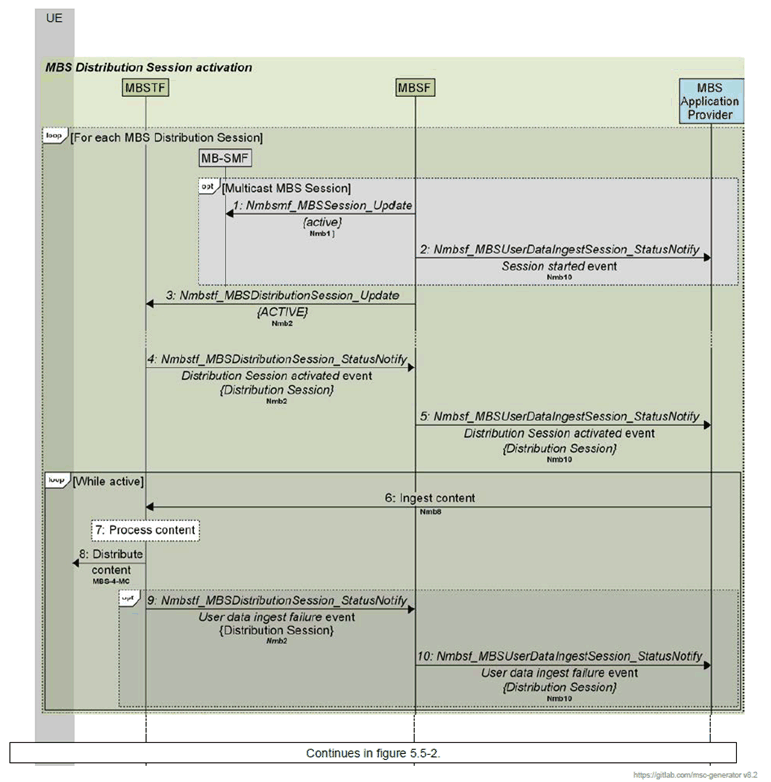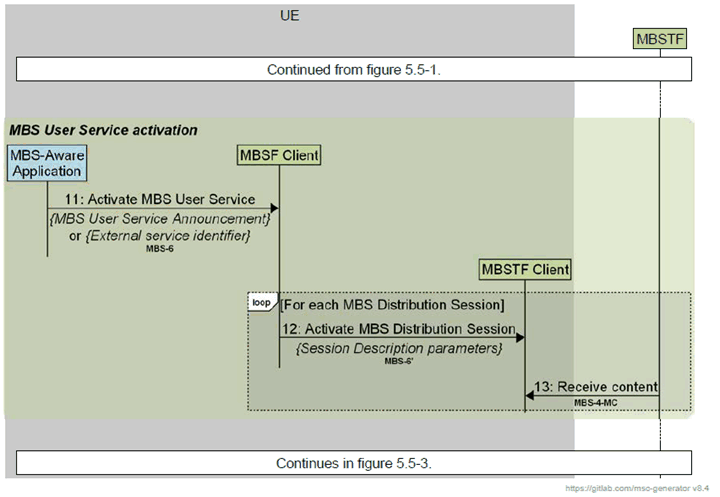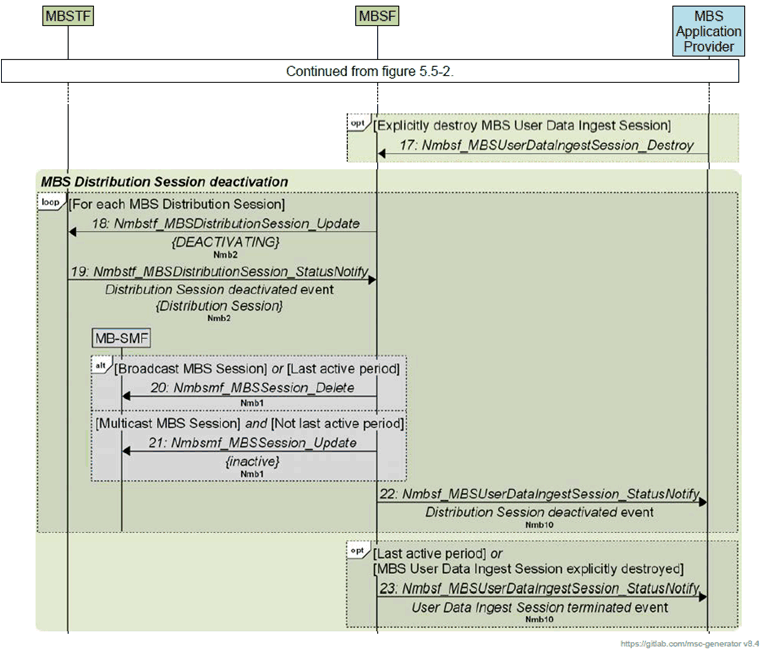Content for TS 26.502 Word version: 18.1.0
5.5 Procedures for User Service data transfer
5.5.1 MBS Distribution Session activation
5.5.2 MBS User Service reception activation
5.5.3 MBS User Service reception termination
5.5.4 MBS Distribution Session deactivation
...
...
5.5 Procedures for User Service data transfer p. 49
5.5.1 MBS Distribution Session activation p. 49
At the next start time indicated in the MBS User Data Ingest Session schedule of active periods, or immediately if no schedule is provisioned, the MBSF activates all MBS Distribution Sessions comprising that MBS User Data Ingest Session, as shown in Figure 5.5.1-1 and Figure 5.5.2-1 below.

Figure 5.5.1-1: Call flow for MBS Distribution Session activation by MBSF
(⇒ copy of original 3GPP image)
(⇒ copy of original 3GPP image)
For each such MBS Distribution Session:
Step 1.
For MBS Distribution Sessions of Service type multicast, the MBSF (re)activates the corresponding Multicast MBS Session in the MB-SMF, allowing UEs to join the MBS Session(s).
Step 2.
Once it is satisfied that the Multicast MBS Session has been successfully established or (re)activated, the MBSF notifies the MBS Application Provider about the successful establishment of the MBS Session(s) corresponding to the MBS Distribution Session using one or more Session started events.
Step 3.
The MBSF invokes the Nmbstf_MBSDistributionSession_Update service operation on the MBSTF at reference point Nmb2, updating the current state of the MBS Distribution Session to ACTIVE (see step 3 in clause 4.6.1). The state of the MBS Distribution Session in the MBSTF remains ACTIVE (see step 3 in clause 4.6.1); on failure, it transitions through DEACTIVATING to INACTIVE (see step 4 in clause 4.6.1).
Step 4.
The MBSTF notifies the MBSF about the successful activation of the MBS Distribution Session by sending the Distribution Session activated event.
Step 5.
The MBSF notifies the MBS Application Provider about the successful activation of the MBS Distribution Session by sending the Distribution Session activated event.
Step 6.
As a direct result of step 3, the MBSTF begins to ingest content from the MBS Application Provider (if the pull-based Object acquisition method is provisioned) or starts accepting content published by the MBS Application Provider (if the Packet Distribution Method or the push-based Object acquisition method is provisioned).
Step 7.
The MBSTF may process the ingested content according to the provisioned distribution method, as defined in clause 4.3.3. This may optionally include the computation of Application Layer FEC (AL-FEC) information.
Step 8.
The MBSTF distributes the resulting MBS data at reference point MBS-4-MC. This is achieved by passing the MBS data to the MB-UPF via reference point Nmb9 and/or to the MBMS-GW via reference point SGi-mb, according to the protocol stacks defined in clause 8.2 of TS 23.247.
Step 9.
On unsuccessful content ingest and MBS data distribution, the state of the MBS Distribution Session in the MBSTF may transition through DEACTIVATING to INACTIVE (see step 4 in clause 4.6.1) in case of a severe fault.
Regardless of the severity of the fault, the MBSTF invokes the Nmbstf_MBSDistributionSession_StatusNotify callback service operation at reference point Nmb2 using the User data ingest failure event to inform the MBSF of the failure.
Step 10.
The MBSF invokes the Nmbsf_MBSUserDataIngestSession_StatusNotify callback service operation at reference point Nmb10 (or Nmb5+N33, if invoked via the NEF) using the User data ingest failure event to inform the MBS Application Provider of the failure.
5.5.2 MBS User Service reception activation p. 51
The MBS Client in the UE activates reception of an MBS User Service by establishing an MBS User Service Session between the MBSF Client and the MBSF, and consequently activating reception of one or more MBS Distribution Sessions by the MBSTF Client that are currently being distributed by the MBSTF. This call flow is shown in Figure 5.5.2-1 below:

Figure 5.5.2-1: Call flow for MBS User Service activation by MBS Client
(⇒ copy of original 3GPP image)
(⇒ copy of original 3GPP image)
The steps are as follows:
Step 11.
For each MBS Distribution Session listed in the composite MBS User Service Announcement:
The MBS-Aware Application invokes a client API exposed by the MBSF Client at reference point MBS-6 to activate the MBS User Service Session.
If the MBS User Service Announcement was received by the MBS-Aware Application in step 2c in clause 5.4, this is passed as one of the parameters in the API call.
Otherwise, the target service is identified by one of the external service identifiers in the MBS User Service entity (see clause 4.5.3) and this identifier is used by the MBSF Client to locate an MBS User Service Announcement obtained according to step 2a or step 2b in clause 5.4.
Step 12.
The MBSF Client invokes a client API exposed by the MBSTF Client at reference point MBS-6' to activate reception of the MBS Distribution Session in question. The Session Description parameters needed to receive the MBS Distribution Session are taken from the relevant MBS Distribution Session Announcement which, in turn, is extracted from the composite MBS User Service Announcement.
Step 13.
MBS data from the MBSTF is received by the MBSTF Client at reference point MBS-4-MC.
5.5.3 MBS User Service reception termination p. 52
The MBS Client in the UE terminates reception of an MBS User Service by deactivating the MBS User Service Session between the MBSF Client and the MBSF, and consequently deactivating reception of all MBS Distribution Sessions currently being received by the MBSTF Client within the scope of that MBS User Service Session. This call flow is shown in Figure 5.5.3-1 below:

Figure 5.5.3-1: Call flow for MBS User Service activation by MBS Client
(⇒ copy of original 3GPP image)
(⇒ copy of original 3GPP image)
The steps are as follows:
Step 14.
For each MBS Distribution Session:
The MBS-Aware Application invokes a client API exposed by the MBSF Client at reference point MBS-6 to deactivate the MBS User Service Session. The target service is identified by one of its external service identifiers.
Step 15.
The MBSF Client invokes a client API exposed by the MBSTF Client at reference point MBS-6' to deactivate reception of the MBS Distribution Session in question.
Step 16.
As a consequence of the previous step, MBS data from the MBSTF is no longer received by the MBSTF Client at reference point MBS-4-MC.
5.5.4 MBS Distribution Session deactivation p. 53
At the next end time indicated in the MBS User Data Ingest Session schedule of active periods, the MBSF deactivates all MBS Distribution Sessions comprising that MBS User Data Ingest Session. This call flow is shown in Figure 5.5.4-1 below:

Figure 5.5.4-1: Call flow for MBS Distribution Session deactivation by MBSF
(⇒ copy of original 3GPP image)
(⇒ copy of original 3GPP image)
Step 17.
The steps for deactivation of each MBS Distribution Session are as follows:
(Optional) The MBS Application Provider may explicitly terminate the MBS User Data Ingest Session at any time.
Step 18.
Finally, once all MBS Distribution Sessions in the scope of the parent MBS User Data Ingest Session have been torn down:
The MBSF invokes the Nmbstf_MBSDistributionSession_Update service operation on the MBSTF at reference point Nmb2, updating the current state of the MBS Distribution Session to DEACTIVATING (see step 5 in clause 4.6.1).
Step 19.
The MBSTF notifies the MBSF about the successful deactivation of the MBS Distribution Session by sending the Distribution Session deactivated event.
Step 20.
When Session type is broadcast or if the current period is the last in the schedule, the MBSF tears down the MBS Session(s) corresponding to the MBS Distribution Session.
Step 21.
When Session type is multicast and the current period is not the last active period in the schedule, the MBSF deactivates the MBS Session corresponding to the MBS Distribution Session in question.
Step 22.
Once it has completed sending the data it had already ingested, the MBSF notifies the MBS Application Provider about the deactivation of the MBS Distribution Session by sending the Distribution Session deactivated event.
Step 23.
The MBSF notifies the MBS Application Provider about the termination of data ingest by sending the User Data Ingest Session terminated event.